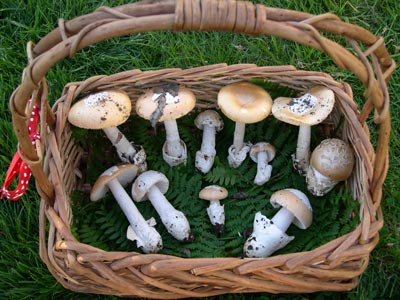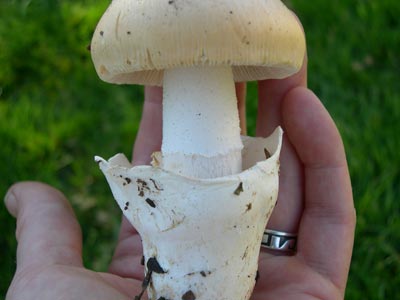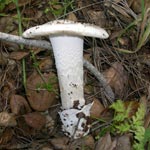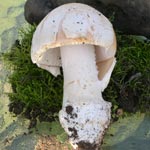Amanita velosa, the "Springtime Amanita"

© photo by Debbie Viess
Sweet and delicious, fishy-smelling, many color morphs, and
deadly look-alikes.
The beautiful pale apricot to salmon to tan Amanita velosa is a welcome component of our California live oak woodlands. A West Coast species, they range from Northern Mexico through Southern California (they have even been recorded on the Channel Islands!), across Northern California and on into Southwest Oregon, wherever live oak is found. Here in the Bay Area, they are mycorrhizal with coast live oak. Velosas inhabit a unique niche: fruiting on the ground at the drip line of and sometimes far removed from the oak tree itself. Velosas can sometimes be found fruiting far out in sunny meadows, if those meadows are also adjacent to an oak.
Like all amanitas, velosa are formed within an egg called the universal veil. This membrane ruptures as the mushroom expands. When broken, the veil forms a limbed, cup-like volva at the base of the stem or stipe; the inner surface of the volva is often stained the same color as the cap. Typically, a patch of universal veil material is also left on the cap, although the veil can break into warts, or be lost altogether during certain environmental conditions.

note pseudo-skirt
© photo by Debbie Viess
The stipe itself is generally uniform in width, and never has a bulbous base like the toxic amanitas. The stipe can either expand or narrow where it meets up with the cap. It is hollow, and stuffed with cottony or gelatinous pith. Amanita velosa is a member of section vaginata, and like the grisettes, lacks a partial veil, which covers the developing gills. Although you will never see a true annulus on this mushroom, sometimes there is a bit of material left on the stipe where the cap edge and veil was attached prior to expansion; this small ring of material is sometimes referred to as a pseudo-skirt (see photo). Above this zone, the white stipe of a velosa can often have a shaggy appearance.
 |
 |
 |
white phase velosas © photos by Debbie Viess |
note color on inner volva surface | |
As in many amanita species, cap color can be extremely variable. From the classic pale apricot form found here in the East Bay, to the pink tones found in a “cooked-salmon” colored cap, to the faded by sun and rain tan-colored cap, to the controversial (in some circles) “hen’s egg brown” cap of the Santa Cruz area, you can expect a lot of velosa colors in the field. Regardless of color or age, the edge of the cap is always striate, even when the mushroom cap is unexpanded.
In my California collecting experience, Amanita velosa regularly produces pure white forms, more often than any other species of colored amanita. These “Moby Mushrooms” are identical to a velosa in all aspects but color. White phase velosas are not recommended for the table however, due to their uncomfortable similarity to our California variety of the “Destroying Angel”, Amanita ocreata.
As it matures, Amanita velosa produces a fragrance of fish or shellfish. As is true of other distinctive mushroom fragrances, like the phenolic odor found in the Agaricus “barficus” group, the ability to smell these odors is genetically determined.
Like all amanitas, velosas are highly perishable and should be eaten within a day or two of picking. It’s important to keep the dirt out of the gills when you first collect them. Once they have been identified beyond any shadow of a doubt, they should be stripped of their volva and other veil material, and gently wiped clean with a damp paper towel. When cut, their stems resemble rings of calamari. They are best cooked in a bit of butter until lightly browned. Their fragrance while cooking is unique and intoxicating, and their taste sweet, slightly nutty and delicious. I like to enjoy them in their simplest rendition, over pasta in a simple butter sauce (olive oil works, too). Cooked asparagus, another harbinger of spring, is also a nice addition to this pasta.
Amanita ocreata is a white to tan, deadly, native amanita that also occurs with coast live oak in the spring. It differs from velosa in several ways: by its growth underneath the tree canopy, rather at the drip line and beyond, lack of cap striations when young, the presence of a true annulus (a feature that can be lost), and having a pronounced bulb at the base of the stipe.
Another deadly potential look-alike is the introduced and spreading Amanita phalloides. Phalloides also fruit with coast live oak, and although they primarily occur earlier in the season, can fruit at the same time as velosas. Phalloides have highly variable cap color, and some can resemble a faded, tan-capped velosa; I have seen velosa and phalloides almost identical in color, side by side under live oak, in the Sierra foothills in the spring. Unlike velosas, phalloides have a partial veil or annulus, but this delicate feature is easily lost. A phalloides will always have a bulbous base, however, even after you strip off the membranous volva.
But eating amanitas is not a safe practice for beginning mushroom hunters. Anyone can learn how to distinguish the edible from the toxic or deadly species, but it takes many seasons to develop your eye and field experience. When collecting amanitas for the table, it is recommended that you only eat type specimens (a mushroom that has all of the characteristics of the species, so no color/veil/habitat anomalies), that you spend several seasons collecting many before you eat any, and that you check your ID with another local amanita expert or local mycological society. No mushroom meal, no matter how delicious, is worth your life.
Until that time, enjoy the beauty and diversity of this marvelous mushroom. It is a favorite of photographers and artists as well as gourmands. So get outside and rejoice in our burgeoning California spring. When you’re walking through an oak woodland, dripping with catkins and alive with singing birds, perhaps you’ll encounter your very first patch of Amanita velosa. If so, give them my regards, and tell 'em, "Rita sent you."
© Debbie Viess

 back to top
back to top